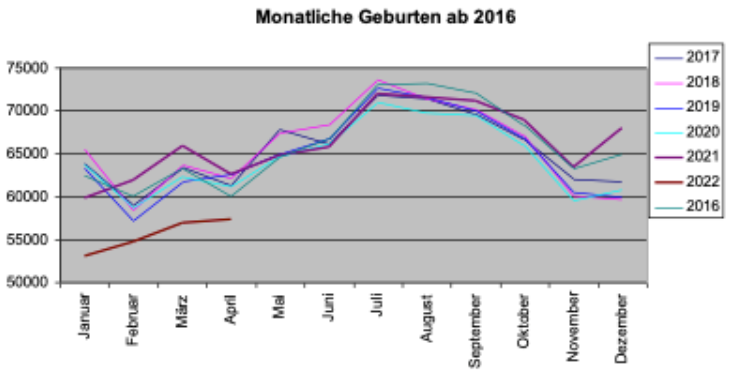Germany has seen a “dramatic drop” in birthrate during the first 4 months of 2022, according to transitionnews.de here, leading to rising suspicions over COVID vaccine safety.
“Compared to the previous year, the number of births has fallen by 12 percent – that’s about 25,000 fewer births in the first four months of 2022,” reports Sternfried Müller of transitionnews.de.
Chart source: transitionnews.de
The above chart shows the number of births for the January-April period each year since 2018. During the Corona years of 2020 and 2021, Germany saw a rise in the number of births, climbing to 250,000 births. But in 2022, the number of births mysteriously plummeted a whopping 12%!
Something unusual must have triggered the phenomenon. Going back 9 months prior to the January-April 2022 period takes us to the April to July 2021 period, which coincides to COVID vaccination of younger adults in earnest. Remarkably, Germany’s media have been silent on the latest published statistics, issued by the German Federal Statistical Office (Destatis).
The next transitionnews.de chart shows the monthly number of births and just how dismally 2022 lags so far compared to the previous years:
Chart source: transitionnews.de
A number of reasons have been proposed to explain the dramatic decline, among them fewer marriages. But that remains highly doubtful.
There are increasing suspicions that it is vaccine linked, as some studies already suggest: see here and here.
For the time being German authorities obstinately continue to remain in denial mode when it comes the the adverse effects of the COVID vaccines. Currently the Ministry of Health is gearing up to roll out another mass wave of vaccinations and restrictions in the run-up to the fall flu season.
See entire article at transitionnews.de
Also read here.







Similar developments in the UK https://expose-news.com/2022/08/10/depopulation-by-covid-vaccination-confirmed/
Most likely spurious data
High rate of inflation makes people concerned
about starting a family or having more children
But the years 2020, 2021, with considerable social upheaval due to covid showed a rise in births. However another telling statistic would be that of still births and failed pregancies following mass vaccination. If they show a rise it gives weight to the arguement that vaccines are damaging fertility, and if you add the still births+ failed pregancies to the live births and the effective rate of conceptions are as in previous years it blows the inflation arguement out of the water.
2020 and 2021 had small increases — chart shows 2021 about the same as 2018
For the last 70 years, fertility rates have decreased worldwide, with a total 50% decline. Reasons include women’s empowerment in education and the workforce, lower child mortality and the increased cost of raising children.
The German economy is having slow growth and high inflation in 2022.\
Both discourage marriage, starting a family or expanding a family.
Do you have any statistics on the trends of still births and failed pregnancies in 2022 versus 2021?
Yes – people have children when they are hopeful for the future, not when they are worried about being able to heat their home in the winter
No, people have children when there is a crisis and with a loss of job and in the last two years when they where working from home.
Btw nobody was worried about heating their homes 9 month ago, yet …
Planned depopulation by the globalists. COVID was fake (there was no “virus”)- the real bioweapon is the clot shots:
https://www.armstrongeconomics.com/world-news/tyranny/the-stupid-will-believe-it-and-ask-to-be-treated-pandemic-to-depopulate-1981/
https://blogs.mercola.com/sites/vitalvotes/archive/2022/08/10/pregnant-mother-coerced-into-taking-the-shot.aspx
Don’t even have to read it, to know it’s bollocks.
Anybody claiming Covid-19 doesn’t exist, is a charlatan, anybody who believes them, an idiot.
O know 12 people who were infected by fake Covid in 2020
[…] Infertility Pandemic: Number Of Births In Germany For January-April 2022 Period Plummets 12% […]
An Australian doctor speaks out:
https://cairnsnews.org/2022/08/02/dr-william-bay-gatecrashes-australian-medical-association-meeting/
The phrase “infertility pandemic” implies something unknown.
A study needs to show that the practice that leads to conception among the most fertile couples has remained robust while births decline, and that the size of that group has remained constant.
Otherwise, an alternative based on demographic dynamics ought to be investigated.
The age cohorts of Germany show a definite decrease in the 0 to 10 ages compared to Saudi Arabia. Germany’s population peaked in 2019.
https://www.populationpyramid.net/saudi-arabia/2019/
Saudi Arabia’s birth rate is declining by about 2.7% per year over the last few years. 75% less than the 12% of Germany. The country, S. A., reports a total of 66,700,629 vaccine doses have been administered. Population is expected to peak in 2060.
So, people did a lot of shagging during lockdowns. More children born, families considered to be complete – only want one or two children – so birth rates declined afterwards.
Simplest explanation.
Maybe the best explanation
A long-term trend of a declining birth rate
It is interrupted for two years (2020 and 2021)
with births above the trend
(I’ll assume your explanation is right)
If you are right, then 2022 and 2023 are likely to be below the long term trend.
In five more years, it would become obvious whether or not the long-term downtrend of births is still in progress
[…] Source […]
[…] Source […]
[…] Source […]